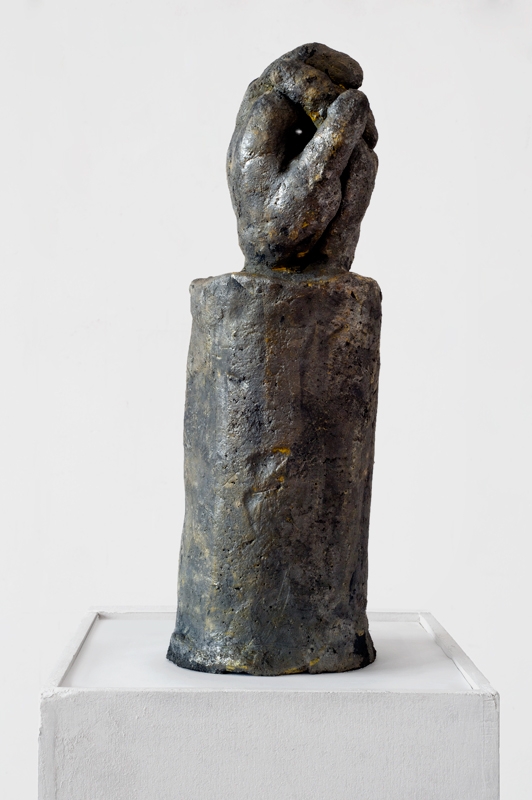In 1975 Pier Paolo Pasolini wrote, ‘At the beginning of the sixties, the fireflies began to disappear in our nation, due to pollution of the air, and the azure rivers and limpid canals, above all in the countryside. This was a stunning and searing phenomenon. There were no fireflies left after a few years.’ These reflections – which appeared in an article entitled ‘Il Vuoto del Potere in Italia’ (‘The Power Void in Italy’) in Corriere Della Sera – were intended as a metaphor for a changing political culture which came about both as subtly and as suddenly as the disappearance of fireflies.
At that point Pasolini bemoaned the abstraction of political dialogue which had become ‘as incomprehensible as Latin’, allowing those in government to ‘retain power at all costs’. Pasolini’s essay is celebrated in Gianni Dessì’s solo show Dentro e Fuori (Inside and Outside) at Fondazione Pastificio Cerere, in Rome’s San Lorenzo neighbourhood, with the work Lucciola (Firefly, 2012). The ceramic piece depicts two hands held tightly and leaving just a small opening through which a dim intermittent light can be seen flashing. For the artist this represents the possibility of nurturing some kind of positive future, reflecting that ultimately, ‘fundamentally, artists do no more than search to possess these fireflies’. The exhibition is the first of six that make up Sei di Nostri (Six of Our Own), a cycle celebrating the tenth anniversary of Fondazione Pastificio Cerere and the 110th anniversary of the building (an ex-pasta factory) that hosts it and which has housed artist studios since the postwar period.
A traditionally leftwing district that houses Sapienza University’s faculty of psychology, San Lorenzo remains true to the spirit of Rome as an unruly city marking the beginning of Southern Italy. Its chaotic mix of students, immigrants, pushers and leftwing skinheads holds a beacon for a sense of disorderly humanity that is being purged year on year in Italy by a new wave of politicians speaking an abstract language of commerce and gentrification.
At an international level, much is made of the apparent lack of a viable political response from the art scene in face of the abstraction of mainstream politics on a global level, with critics frequently bemoaning the prevalence of ‘crapstraction’ and ‘zombie abstraction’ at art fairs. Though it is worth reflecting that the current prevalence of abstraction in painting may be a perfectly adequate and rational response to an irrational society, with its roots in the history of painting. Artist Gianni Politi, who has a studio in the ex-Pastificio, recently showed a body of 18 paintings at GNAM (the Galleria Nazionale d’Arte Moderna, Rome) in an exhibition entitled Tra Queste Sale (Malandrino). The show saw Politi’s works – comprising collaged painted papers on canvas – placed above and beside GNAM’s permanent collection of nineteenth-century Italian painting dedicated to myth, history and landscape. The interaction between Politi’s works and the works of, for example, the realist painter Giuseppe Abbati demonstrated both the genesis of abstract mark-making in pre-abstract movements and the kernel of abstraction that has always been present in painting. The way in which, for example, a masterfully rendered realist landscape gives way on close inspection to a series of marks of tightly meshed coloured strokes was reflected in the abstract marks of Politi’s works, which – conversely – evoked and suggested some kind of formal sense.
It is unlikely that painters prior to the advent of abstraction in the twentieth century were unconscious of the effect of their carefully crafted figures falling away into an abstract mesh of pigment, linseed and cotton duck canvas. One can only assume that the abstract messages left for the viewer in the works displayed at GNAM – which came to the foreground alongside Politi’s outright abstract works – were intentional attempts to make sense of the abstract and unfathomable core of work, nature and love. As social life becomes more and more abstract and work relations in the twenty-first century become more and more separated from nature, it is hardly surprising that a generation turns to direct abstraction to make sense of it all. We can choose to ridicule this generation as a byproduct of the abstract finance mechanism that has taken hold of the artworld and forced it to produce same-y abstract works en masse. This, however, would be a little unfair to the history of painting that the current generation of abstract artists has inherited. Politi recalls walking the galleries of the GNAM as a five-year-old with his late father. He is surely not the only young abstract painter with a personal and historical connection to the discipline.
This article was first published in the April 2015 issue.
